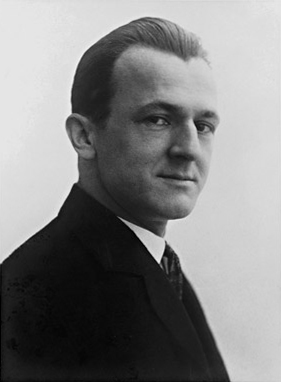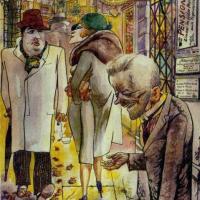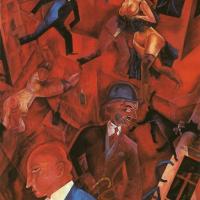George Grosz
Berlin Street Scene
$450.00
Metropolis
$450.00
George Grosz
George Grosz (1893-1959)
George Grosz (July 26, 1893 – July 6, 1959) was a German artist known especially for his caricatural drawings and paintings of Berlin life in the 1920s. He was a prominent member of the Berlin Dadaand New Objectivity group during the Weimar Republic. He immigrated to the United States in 1933, and became a naturalized citizen in 1938. Abandoning the style and subject matter of his earlier work, he exhibited regularly and taught for many years at the Art Students League of New York. In 1959 he returned to Berlin where he died.

Grosz was born Georg Ehrenfried Groß in Berlin, Germany, the son of a pub owner. His parents were devoutly Lutheran. Grosz grew up in the Pomeraniantown of Stolp (now Słupsk, Poland), where his mother became the keeper of the local Hussars Officers' mess after his father died in 1901. At the urging of his cousin, the young Grosz began attending a weekly drawing class taught by a local painter named Grot. Grosz developed his skills further by drawing meticulous copies of the drinking scenes of Eduard von Grützner, and by drawing imaginary battle scenes. From 1909 to 1911, he studied at the Dresden Academy of Fine Arts, where his teachers were Richard Müller, Robert Sterl, Raphael Wehle, and Osmar Schindler. He subsequently studied at the Berlin College of Arts and Crafts under Emil Orlik.
In November 1914 Grosz volunteered for military service, in the hope that by thus preempting conscription he would avoid being sent to the front. He was given a discharge after hospitalization for sinusitis in 1915. In 1916 he changed the spelling of his name to "de-Germanise" and internationalise his name – thus Georg became "George" (an English spelling), while in his surname he replaced the German "ß" with its phonetic equivalent "sz". He did this as a protest against German nationalism and out of a romantic enthusiasm for America-a legacy of his early reading of the books of James Fenimore Cooper, Bret Harte and Karl May - that he retained for the rest of his life. His artist friend and collaborator Helmut Herzfeld likewise changed his name to John Heartfield at the same time.
In January 1917 Grosz was drafted for service, but in May he was discharged as permanently unfit.
In the last months of 1918, Grosz joined the Spartacist League, which was renamed the Communist Party of Germany (KPD) in December 1918. He was arrested during the Spartakus uprising in January 1919, but escaped using fake identification documents. In 1921 Grosz was accused of insulting the army, which resulted in a 300 German Mark fine and the destruction of the collection Gott mit uns ("God with us"), a satire on German society. In 1928 he was prosecuted for blasphemy after publishing anticlerical drawings, such as one depicting prisoners under assault from a minister who vomits grenades and weapons onto them, and another showing Christ coerced into military service. According to historian David Nash, Grosz "publicly stated that he was neither Christian nor pacifist, but was actively motivated by an inner need to create these pictures", and was finally acquitted after two appeals. By contrast, in 1942 Time magazine identified Grosz as a pacifist.
In 1922 Grosz traveled to Russia with the writer Martin Andersen Nexø. Upon their arrival in Murmansk they were briefly arrested as spies; after their credentials were approved they were allowed to meet with Grigory Zinoviev, Anatoly Lunacharsky, and Vladimir Lenin. Grosz's six-month stay in the Soviet Union left him unimpressed by what he had seen. He ended his membership in the KPD in 1923, although his political positions were little changed.
Bitterly anti-Nazi, Grosz left Germany shortly before Hitler came to power. In June 1932, he accepted an invitation to teach the summer semester at the Art Students League of New York. In October 1932, Grosz returned to Germany, but on January 12, 1933, he and his family emigrated to the United States. Grosz became a naturalized citizen of the U.S. in 1938, and made his home in Bayside, New York. In the 1930s he taught at the Art Students League, where one of his students was Romare Bearden, who was influenced by his style of collage. He taught at the Art Students League intermittently until 1955.
In America, Grosz determined to make a clean break with his past, and changed his style and subject matter. He continued to exhibit regularly, and in 1946 he published his autobiography, A Little Yes and a Big No. In the 1950s he opened a private art school at his home and also worked as Artist in Residence at the Des Moines Art Center. Grosz was elected into the National Academy of Design as an Associate Academician in 1950. In 1954 he was elected to the American Academy of Arts and Letters. Though he had U.S. citizenship, he resolved to return to Berlin, and relocated there in May 1959. He died there on July 6, 1959, from the effects of falling down a flight of stairs after a night of drinking.
Grosz's art influenced other New Objectivity artists such as Heinrich Maria Davringhausen, Anton Räderscheidt, and Georg Scholz. In the United States, the artists influenced by his work included the social realists Ben Shahn and William Gropper.
In 1960, Grosz was the subject of the Oscar-nominated short film George Grosz' Interregnum. He is fictionalized as "Fritz Falke" in Arthur R.G. Solmssen's novel A Princess in Berlin (1980). In 2002, actor Kevin McKidd portrayed Grosz in a supporting role as an eager artist seeking exposure in Max, regarding Adolf Hitler's youth.
The Grosz estate filed a lawsuit in 1995 against the Manhattan art dealer Serge Sabarsky, arguing that Sabarsky had deprived the estate of appropriate compensation for the sale of hundreds of Grosz works he had acquired. In the suit, filed in State Supreme Court in Manhattan, the Grosz estate claims that Sabarsky secretly acquired 440 Grosz works for himself, primarily drawings and watercolors produced in Germany in the 1910s and 20s. The lawsuit was settled in summer in 2006.
In 2003 the Grosz family initiated a legal battle against the Museum of Modern Art in New York City, asking that three paintings be returned. According to documents, the paintings were sold to the Nazis after Grosz fled the country in 1933. The museum never settled the claim, arguing that a three-year statute of limitations in bringing such a claim had expired. It is well documented that the Nazis stole thousands of paintings during World War II and many heirs of German painters continue to fight powerful museums to reclaim such works.
George Grosz's younger son is jazz guitarist Marty Grosz.




